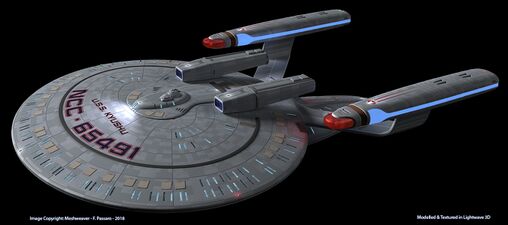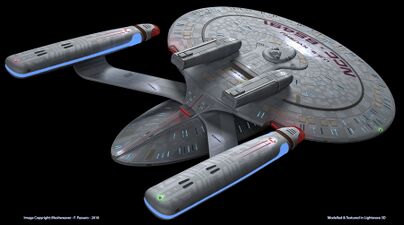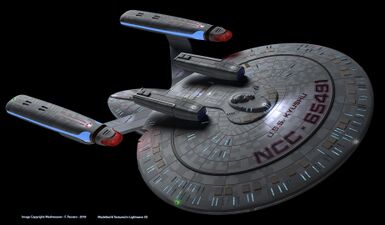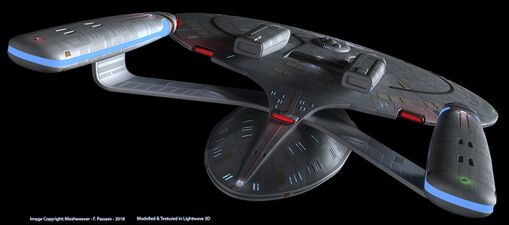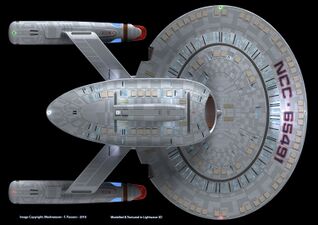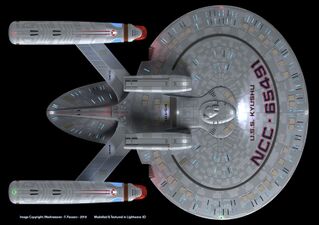New Orleans Class
More actions
The New Orleans-class frigate is a mid-sized multi-role starship developed in the mid-24th century as part of the Fleet Modernization Program that led to the Galaxy-class explorer. At a glance, the New Orleans could easily be confused for a miniaturized version of the Galaxy, as it shares similar hull geometry and engine design. These vessels were intended to handle general patrol and light exploratory duties, while also supplementing the larger California-class utility cruiser for logistical support missions. Production of this class ended in the 2370s, but they remain in service as a capable and well-rounded vessel.
Exploration and Science
New Orleans-class vessels are often tasked with surveys and other exploratory tasks within the Federation's vast interior. Like other frigates, she has well-rounded but somewhat basic science facilities that are geared towards identifying interesting phenomena for actual science vessels to follow up on. With sensor pods, the New Orleans is quite good at stellar mapping, however, and their long-range sensors can identify habitable worlds that may have been missed on initial exploration.
Relative to the ship's size, the New Orleans has an over-sized main deflector, which enhances its ability to sustain long-range warp journeys, while also providing additional navigational and long-range sensor equipment. This deflector can also be used to pierce through stellar anomalies, and provide her captain with more confidence when entering debris-rich environments like asteroid belts or debris fields.
When equipped with one or more science pods, the New Orleans can embark multiple specialist lab facilities filled with mission-specific equipment. Now that this class is being displaced by newer and more powerful vessels on patrol vessels, more and more of them can be spared for long-term scientific surveys. Though the pods can't turn them into a fully-fledged science vessel, they are faster to reconfigure than a Springfield, as no internal components need to be swapped out, while also having better speed and tactical capabilities, making them an excellent choice for narrow scientific missions in potentially dangerous areas.
Diplomacy
Though not a front-line vessel, New Orleans-class vessels are perfectly adequate for diplomatic courier responsibilities or light intensity negotiations. Like other ships of their era, they are comfortable, with plush furnishings and warm color tones, which makes it easier to put guests at ease than on some of Starfleet's newer but more austere designs. The primary conference lounge aft of the bridge is suitable for most small-scale diplomatic talks, as is the forward lounge. There are a few sets of VIP quarters which are well-appointed but less spacious than on diplomatic vessels, and there are fewer provisions aboard to handle large entourages. Like the California, the New Orleans is often used for second or third contact missions to provide logistical support to worlds newly contacted by the Federation.
Engineering
New Orleans-class starships share much in common with other vessels built during the 2350s and 2360s, with a saucer, stardrive section, and two nacelles arranged in a relatively traditional configuration, though the New Orleans was one of the first classes to nearly eliminate the interconnecting "neck" section between the primary and secondary hulls. When they were first constructed, they were packed with new and experimental systems, but a half-century of experience with the class has led to significant streamlining of their maintenance protocols. Systems have been kept updated over the years, but many processes continue to require crew intervention and have not yet been completely automated like they have on newer vessels.
While the Challenger was the prototype vessel for the full-size class-7 nacelles for the Galaxy and Nebula, the New Orleans uses a smaller version of the same overall configuration in scale with the rest of the ship, which results in lower sprint speed than her cousin, but more stability in the warp field. Over the years, the maximum cruising speed has been raised to a swift warp 9, but their absolute top speed can't keep up with newer vessels.
The New Orleans-class also performs remarkably well at sublight speeds. Designed with more modern approaches to hull geometry, including incorporating an oval-shaped saucer section as opposed to the more traditional circular designs seen in decades prior, the vessel is remarkably agile and relatively easy to control at impulse speeds thanks to its wider triple impulse engine layout.
Modular Pods
One of the most unique features of the New Orleans-class is its set of three modular pods. These pods are roughly rectangular in shape and offer two decks of mission-configurable space outboard to the main hull, which preserves space within the hull for crew quarters. The connection points have pass-throughs for turbolifts, power, and data, and they can jettison the pods in an emergency. By default, New Orleans-class vessels were built with enhanced long range sensors mounted in these pods, but Starfleet has authorized several other options:
- Sensor Pods: Forward, a large set of sensor equipment, and aft supplementary power generators for the sensors, and one science lab on each deck with direct, physical connections to the sensors.
- Science Pods: Four mission-configurable science labs, two on each deck, with a small forward sensor cluster. While it doesn't have the range of a sensor pod, it can mount bespoke equipment more easily.
- Cargo Pods: An open two-deck cargo hold which can be configured for general goods, or bulk dry goods, or fluid storage. It can be divided into up to eight separate compartments (four on each deck) if necessary. These pods are easy to produce and reconfigure, and can be fitted with their own cargo transporters.
- Passenger Pods: On both decks, 20 en suite staterooms with double beds, for up to eighty passengers, along with supplemental life support equipment and emergency batteries, which allows the pod to serve as a self-contained lifeboat for up to 72 hours when fully loaded.
- Ambulance Pods: On both decks, wards for 20 patients and a gurney-sized transporter for beaming patience aboard, for a total of 40 patients. Medical support is provided by an EMH program and four nursing holograms that supplement the ship's own medical staff. As with passenger pods, there is supplementary life support equipment and emergency batteries that allow the pod to serve as a self-contained lifeboat for up to 72 hours.
- Hospital Pods: On the upper deck, an ICU facility with six standard biobeds, two surgical suites, and a gurney-sized transporter. On the lower deck, a recovery ward for 20 patients. Supplementary life support equipment and emergency batteries allow the pod to serve as a self-contained lifeboat for up to 72 hours.
- Tractor Beam Pods: An industrial-sized tractor beam generator in the center of the pod with emitters on both ends, allowing the ship to manipulate large objects fore or aft. Supplementary fusion generators are included to ease the strain on the ship's own power supply, but the connection points for this pod type must be specially reinforced to handle the added strain of towing large objects.
- Hanger Pods: A through-deck shuttle bay with doors on both ends of the pods, capable of accommodating two Danube-class runabouts or six personnel shuttles. There are no onboard repair facilities, so damaged craft must be repaired directly on the bay floor, which can impede launch and recovery operations. This pod is primarily intended for passenger or colonial transport operations, and is not suitable for fighters.
Because of the configuration of the pods relative to the ship's hull geometry and warp field, propulsion efficiency is hampered if the two upper pods aren't the same model, but the lower pod can be of a different type. For patrol duties, New Orleans-class ships typically use three sensor pods, while ambulance vessels use two ambulance pods and one hospital pod, but there are many other permutations. Creating new modules can take several weeks for a starbase to produce, but installation only takes twenty-four hours for most pods other than the tractor beam pods, which require additional structural support.
While these module types can be configured for more specialist mission types internally, each external configuration and mission profile must be carefully tested by the Starfleet Corps of Engineers, because of the potential the pods have to alter the ship's warp field dynamics. While weapons pods were considered, it was judged that the structural and power strain they would create was beyond the limits of the pod connectors.
Tactical
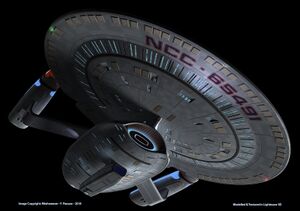
The New Orleans-class boasts impressive offensive and defensive systems for a ship of its size and age. It was designed to test two systems that would later become part of the Galaxy-class design: type-X phaser arrays and burst-fire torpedo launchers. The Type-X phaser arrays were far superior to both the Type-IX arrays used aboard her cousins and to the now-dated Type-VIII banks found aboard the Miranda-class, which the New Orleans was meant to supplant as a frigate. Like all classes built during the fleet modernization program of the 2340s and '50s, the New Orleans has two long phaser arrays on the primary hull, one ventral and one dorsal. There are also six additional arrays: one on the ventral side of each nacelle pylon, one each on the dorsal surface of each nacelle, and two on the ventral surface of the secondary hull, which provide all-around coverage.
The type-4 burst-fire torpedo launchers are located in the "neck" of the ship above the navigational deflector and in the stern of the ship, and they are able to launch torpedoes in bursts of up to four, using a smaller version of the type-10 launcher that would debut on the Galaxy herself.
Because of her well-rounded armaments and relatively traditional design, the New Orleans benefits from combat tactics that have been developed over the generations for similarly-sized classes like the Constitution II, allowing her to employ similar doctrines. This makes the class both an excellent training vessel and an excellent first command for new captains, given that her capabilities don't have any notable peaks or valleys.
When equipped with sensor pods, New Orleans-class vessels have enhanced targeting and stealth detection abilities. They are excellent candidates to accompany squadrons to provide reconnaissance and signals intelligence support, as these dedicated sensor packages can cut through many types of interference.
Shipboard Life
New Orleans-class frigates are among many symbols of Starfleet's thwarted hopes for a peaceful 24th century. While tactically superior to older vessels, her crew quarters and recreational facilities are also significantly more luxurious and comfortable than both the late 23rd-century starships they were intended to replace, and the facilities on the combat-hardened vessels that came after them in the 2370s. This makes service aboard the New Orleans feel either like stepping back into a time capsule to one of Starfleet's golden ages, or like living in a museum, depending on your point of view.
Equipped with several holodecks, gyms, sports courts, an arboretum, and a number of crew lounges on the rim of the saucer, recreation options for a New Orleans crew are numerous. Unlike the California, crew of all ranks are afforded staterooms, though ensigns and below have quarters with shared living rooms and heads. Medical facilities include a standard ICU unit serving as the primary sickbay, along with an additional recovery ward, morgue, and two medical labs. This capability can be supplemented significantly with hospital or ambulance modules.
Neither small nor large, the 300-person crew of the New Orleans is generally a mix of early and mid-career personnel, including ensigns on their first assignments and lieutenants stepping into their first department head roles. This is often a career stepping stone, so crews experience relatively frequent turnover. Captains of these vessels tend to be on the junior side, especially thanks to the staffing issues created by Frontier Day 2401.
Class History
As part of the fleet modernization program throughout the 2340s, the New Orleans was designed to be the fourth and final of series of medium-sized vessels that would supplement and replace where possible the aging Miranda and Constellation-class cruisers. Though the specifications called for a vessel nearly the size of a Constitution-class vessel, the New Orleans was classified as a frigate and was meant to answer the growing tensions along the Cardassian Border. This vessel was chosen to prototype the Type-X phaser arrays that would become standard for the following forty years on Federation vessels, as well as a smaller version of the modular pod system that would be used aboard the Nebula. The default configuration for these pods would be to house powerful long-range sensors for border patrol missions, but they would also enable the vessel to supplement the larger California on logistics support duties around the Federation, up to and including second contact missions.
Designing the New Orleans was a challenge for the Starfleet Corps of Engineers, and initial construction was difficult and costly on the Federation in terms of functionality and resources. The modular mission pod design, in particular, was difficult to perfect, and even Starfleet’s best struggled to find an efficient way to increase the vessels’ warp core power output to match the high demands of all of the vessels new and comparably taxing systems on the EPS grid, even with the support of auxiliary power from the impulse reactors.
Despite the initial struggles of the ship’s development though, its shakedown cruise proved to Starfleet Command just what it could do. Despite initial struggles with maintaining efficient power in all systems, the vessel’s incredible sensor capabilities and new phaser arrays lead to it becoming a first-class choice for a short-range explorer and frigate amongst the Federation’s border regions. In the early months of 2352, the USS New Orleans, the first commissioned vessel of its class, departed from the Utopia Planitia shipyards and headed for the borders of the Cardassian Union.
Though capable and popular in service, this class had a relatively limited production run largely due to factors beyond her control: first and most importantly, she was the last of the line designed before the more capable Nebula-class was introduced and Starfleet generally preferred ordering one of those in favor of three or four of the New Orleans and secondly, the Battle of Wolf 359 led to a dramatic reimagining of Federation shipbuilding and Starfleet’s defensive strategy. While vessels close to completion were finished, no new orders were made after 2370, and production was terminated in favor of the Norway and Steamrunner by 2373. Those that were commissioned however have remained in service for many years. The most famous of the New Orleans-class vessels launched was the USS Rutledge, which earned a reputation as a veteran of the Federation-Cardassian War of the 2350s.
The Starfleet Corps of Engineers made some incredible strides with their development of the New Orleans and many of the lessons learned from both its triumphs and its failures were employed in later ship designs, including those still being developed today. During the 2390s, some of the oldest members of this class were retired. Because of the losses suffered during Frontier Day 2401, all of these vessels are being upgraded and returned to service, and will remain so for the foreseeable future.
The New Orleans In-Play
- One of the classes seen only on screen during the aftermath of the Battle of Wolf 359, the New Orleans is essentially a minaturized, Galaxy-class ship in appearance. Of the four proto-Galaxies in service, it has the most conventional design and had the largest number of orders, so they're more common than oddball designs like the Cheyenne.
- While a solid tactical platform, newer frigates like the Edison or Reliant are preferred for patrols in regions with significant dangers. The New Orleans is more than capable of handling light raiders on its own.
- This would be a good command for a new captain, as they are numerous, modern, and provide an opportunity for a green skipper to learn the ropes.
- Contrary to popular fanon opinion, the three bulbous structures above and below the ship's hull are not torpedo launchers, but are modular pods. Most often, they are sensor pods. The options for the pods are listed above.

